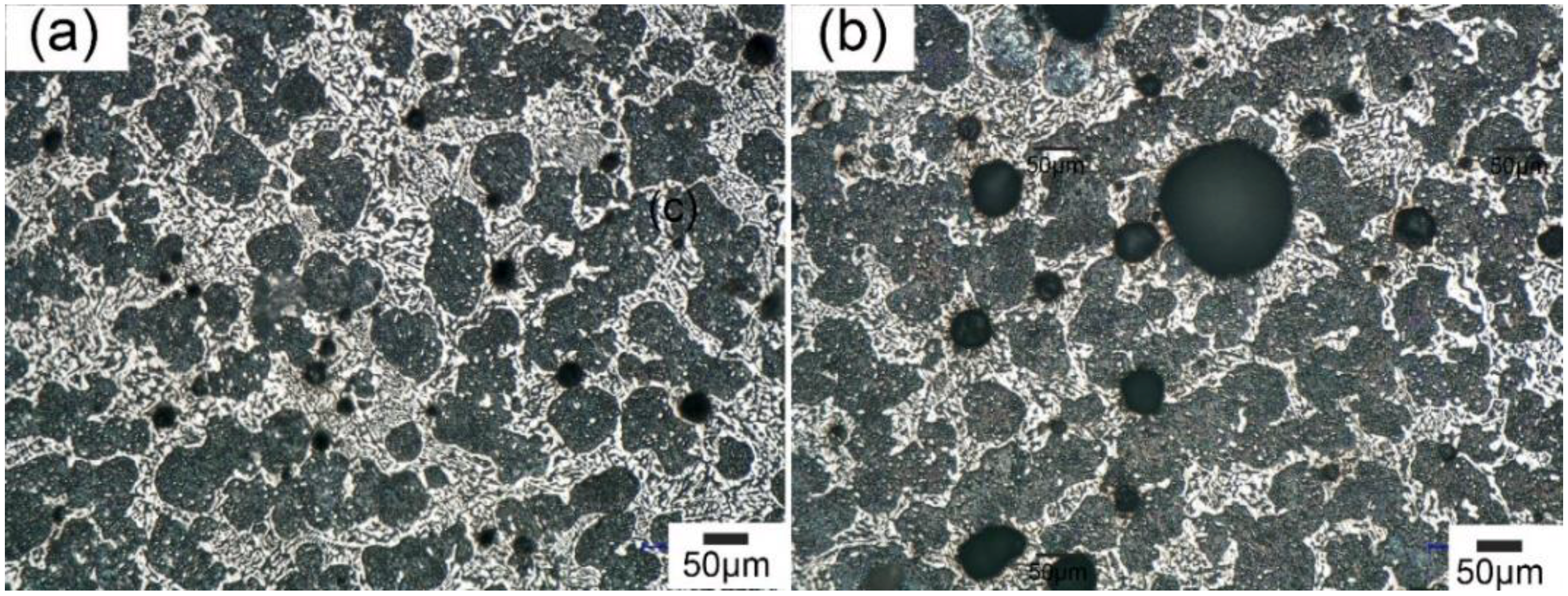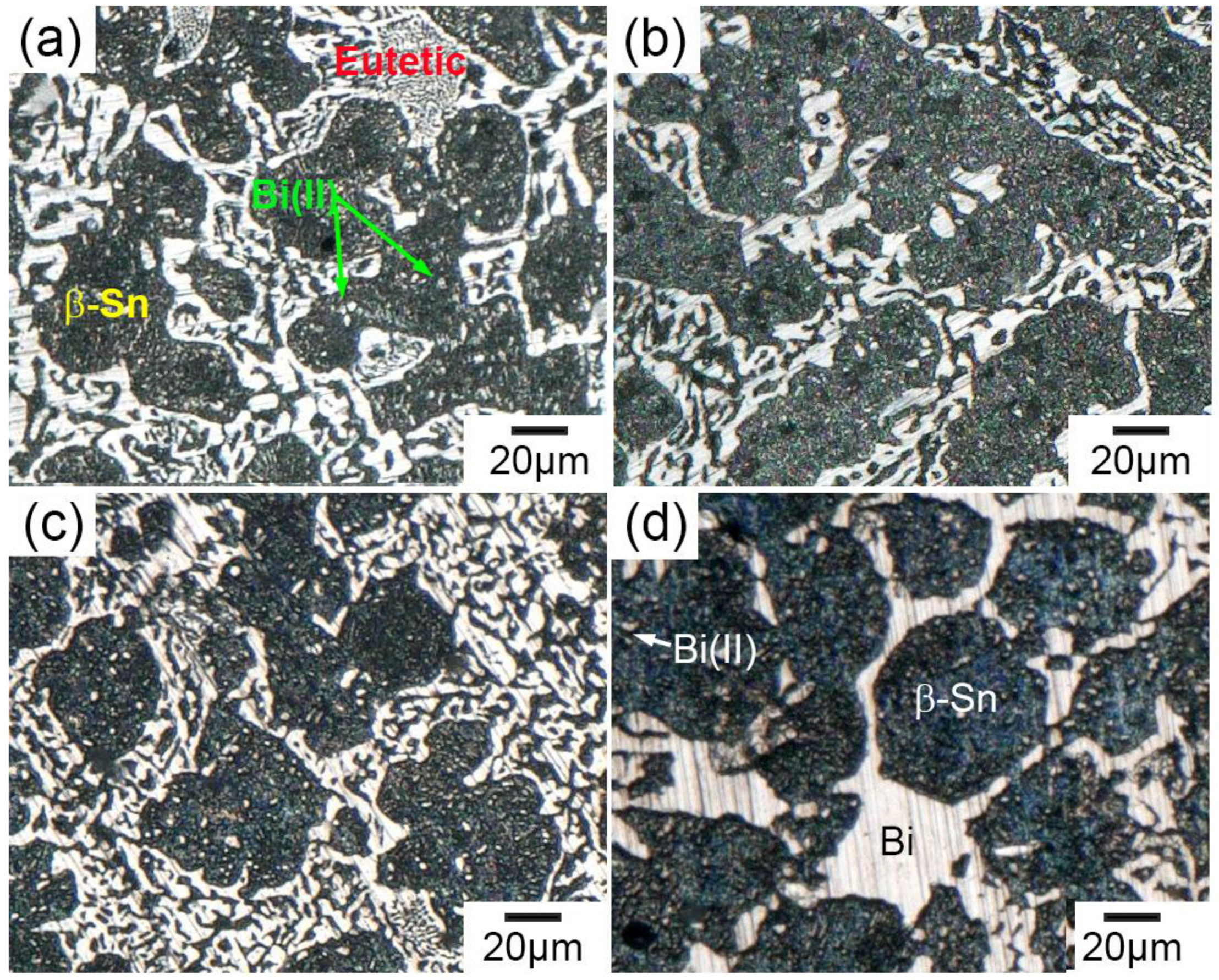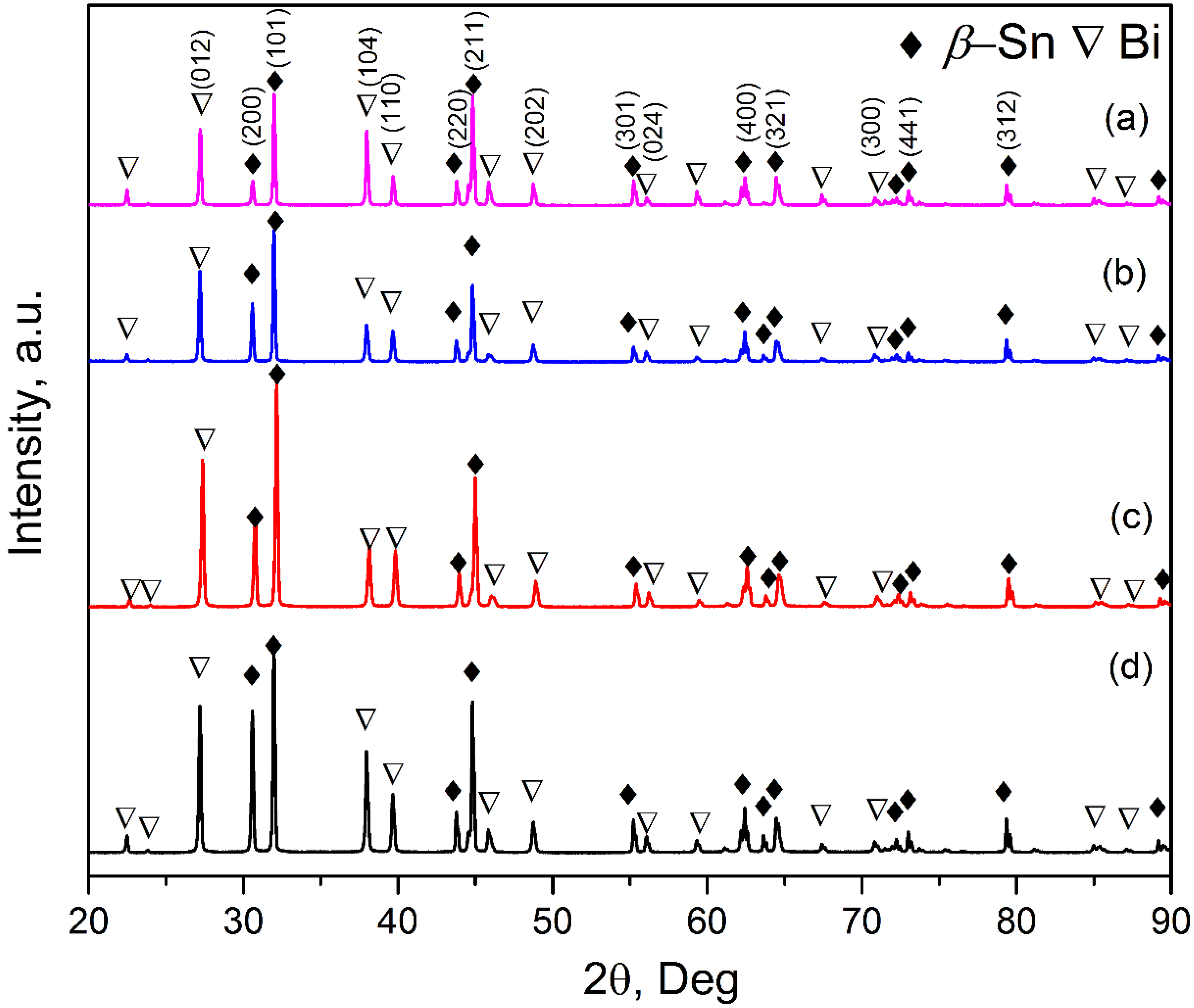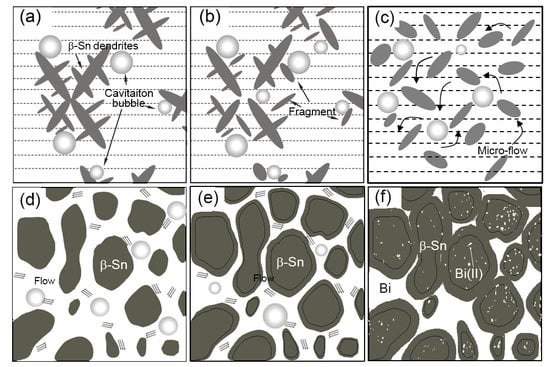A Study on the Effect of Ultrasonic Treatment on the Microstructure of Sn-30 wt.% Bi Alloy
Abstract
:1. Introduction
2. Materials and Methods
2.1. Experimental
2.2. Modeling
2.2.1. Pressure Distribution in Melt
- (1)
- Pressure source , at the surface of the probe tip, where W is the ultrasound power, and A is the area of probe tip;
- (2)
- Sound hard boundary condition with zero normal derivative of the pressure at the sides of the probe;
- (3)
- Sound soft boundary condition at the top end of domain to simulate the liquid/air interface (Pa = 0);
- (4)
- Impedance, Z = ρq · cq at liquid/glass interface.
2.2.2. Pressure Amplitude of an Oscillating Ultrasound Bubble
3. Results
3.1. Microstructure
3.2. The Cavitation Bubble
4. Discussion
4.1. The Effect of UST on the Eutectic
4.2. The Fragmentation Mechanism of UST
5. Conclusions
- (1)
- The primary β-Sn dendrites were fragmented into smaller grains of ~40 μm when the temperature of the ultrasonic treatment was in between liquidus and solidus of the alloy. Divorced eutectic exhibited when the treatment lasted for the whole duration of the solidification.
- (2)
- The UST effective temperature range is between the liquidus and solidus. However, there is no effect when UST is introduced above the liquidus.
- (3)
- The oscillation of the cavitation bubbles broke the solidified Sn dendrites into small fragments which further served as nucleation sites. The ultrasonic treatment generated micro flow around the primary Sn spheres when high solid fraction existed at eutectic temperature, facilitating the dissipation of the rejected Bi atoms, and resulting in the divorced eutectics with the separated growth of β-Sn and Bi phases.
Author Contributions
Acknowledgments
Conflicts of Interest
References
- Eskin, G.I. Broad prospects for commercial application of the ultrasonic (cavitation) melt treatment of light alloys. Ultrason. Sonochem. 2001, 8, 319–325. [Google Scholar] [CrossRef]
- Frenkel, V.; Gurka, R.; Liberzon, A.; Shavit, U.; Kimmel, E. Preliminary investigations of ultrasound induced acoustic streaming using particle image velocimetry. Ultrasonics 2001, 39, 153–156. [Google Scholar] [CrossRef]
- Frampton, K.D.; Minor, K.; Martin, S. Acoustic streaming in micro-scale cylindrical channels. Appl. Acoust. 2004, 65, 1121–1129. [Google Scholar] [CrossRef]
- Eskin, G.I. Principles of Ultrasonic Treatment: Application for Light Alloys Melts. Adv. Perform. Mater. 1997, 4, 223–232. [Google Scholar] [CrossRef]
- Cosgrove, J.A.; Buick, J.V.; Campbell, D.V.; Greated, C.A. Numerical simulation of particle motion in an ultrasound field using the lattice Boltzmann model. Ultrasonics 2004, 43, 21–25. [Google Scholar] [CrossRef] [PubMed] [Green Version]
- Han, Q. Ultrasonic Processing of Materials. Metall. Mater. Trans. B 2015, 46, 1603–1614. [Google Scholar] [CrossRef] [Green Version]
- Atamanenko, T.V.; Eskin, D.G.; Sluiter, M.; Katgerman, L. On the mechanism of grain refinement in Al–Zr–Ti alloys. J. Alloys Compd. 2011, 509, 57–60. [Google Scholar] [CrossRef]
- Jian, X.; Meek, T.T.; Han, Q. Refinement of eutectic silicon phase of aluminum A356 alloy using high-intensity ultrasonic vibration. Scr. Mater. 2006, 54, 893–896. [Google Scholar] [CrossRef]
- Puga, H.; Costa, S.; Barbosa, J.; Ribeiro, S.; Prokic, M. Influence of ultrasonic melt treatment on microstructure and mechanical properties of AlSi9Cu3 alloy. J. Mater. Process. Technol. 2011, 211, 1729–1735. [Google Scholar] [CrossRef] [Green Version]
- Gao, D.; Li, Z.; Han, Q.; Zhai, Q. Effect of ultrasonic power on microstructure and mechanical properties of AZ91 alloy. Mater. Sci. Eng. A 2009, 502, 2–5. [Google Scholar] [CrossRef]
- Yao, L.; Hao, H.; Ji, S.H.; Fang, C.F.; Zhang, X.G. Effects of ultrasonic vibration on solidification structure and properties of Mg-8Li-3Al alloy. Trans. Nonferrous Met. Soc. China 2011, 21, 1241–1246. [Google Scholar] [CrossRef]
- Ramirez, A.; Qian, M.; Davis, B.; Wilks, T.; StJohn, D.H. Potency of high-intensity ultrasonic treatment for grain refinement of magnesium alloys. Scr. Mater. 2008, 59, 19–22. [Google Scholar] [CrossRef]
- Han, L.; Vian, C.; Son, J.; Liu, Z.; Han, Q.; Xu, C.; Shao, L. Grain refining of pure aluminum. In Light Metals 2012, Proceedings of Symposium on Light Metals/TMS Annual Meeting and Exhibition, Orlando, FL, USA, 11–15 March 2012; Suarez, C.E., Ed.; Springer International Publishing: Cham, Switzerland, 2012; pp. 967–971. [Google Scholar]
- Liu, F.; Zhou, Q.; Huang, M.; Huang, J.; Wang, J. Influence of Zr and Ultrasonic on Solidified Structure of Mg_(97)Y_2Cu_1 Alloy. Spec. Cast. Nonferrous Alloys 2016, 36, 1107–1111. [Google Scholar]
- Li, J.; Chen, W.; He, B. Study of probe material for ultrasonic treatment of molten steel. J. Univ. Sci. Technol. Beijing 2007, 29, 1246–1249. [Google Scholar]
- Liu, X.; Osawa, Y.; Takamori, S.; Mukai, T. Grain refinement of AZ91 alloy by introducing ultrasonic vibration during solidification. Mater. Lett. 2008, 62, 2872–2875. [Google Scholar] [CrossRef]
- Jian, X.; Xu, H.; Meek, T.T.; Han, Q. Effect of power ultrasound on solidification of aluminum A356 alloy. Mater. Lett. 2005, 59, 190–193. [Google Scholar] [CrossRef]
- Zhang, X.; Kang, J.; Wang, S.; Ma, J.; Huang, T. The effect of ultrasonic processing on solidification microstructure and heat transfer in stainless steel melt. Ultrason. Sonochem. 2015, 27, 307–315. [Google Scholar] [CrossRef] [PubMed]
- Kang, J.; Zhang, X.; Hu, Y.; Ma, J.; Hu, Y.; Huang, T. Ultrasonic Treatment of the 304 Stainless Steel Melt. ISIJ Int. 2014, 54, 281–287. [Google Scholar] [CrossRef] [Green Version]
- Kattner, U.R. Phase diagrams for lead-free solder alloys. JOM 2002, 54, 45–51. [Google Scholar] [CrossRef]
- Okamoto, H. Bi-Sn (Bismuth-Tin). J. Phase Equilib. Diffus. 2010, 31, 205. [Google Scholar] [CrossRef]
- Shu, D.; Sun, B.; Mi, J.; Grant, P.S. A High-Speed Imaging and Modeling Study of Dendrite Fragmentation Caused by Ultrasonic Cavitation. Metall. Mater. Trans. A 2012, 43, 3755–3766. [Google Scholar] [CrossRef]
- Wang, B.; Tan, D.; Lee, T.L.; Jia, C.K.; Wang, F.; Eskin, D.; Connolley, T.; Fezzaa, K.; Mi, J. Ultrafast synchrotron X-ray imaging studies of microstructure fragmentation in solidification under ultrasound. Acta Mater. 2017, 144, 505–515. [Google Scholar] [CrossRef]
- Lee, T.L.; Khong, J.C.; Fezzaa, K.; Mi, J.W. Ultrafast X-Ray Imaging and Modelling of Ultrasonic Cavitations in Liquid Metal. Mater. Sci. Forum 2013, 765, 190–194. [Google Scholar] [CrossRef]
- Plevachuk, Y.; Sklyarchuk, V.; Gerbeth, G.; Eckert, S.; Novakovic, R. Surface tension and density of liquid Bi–Pb, Bi–Sn and Bi–Pb–Sn eutectic alloys. Surf. Sci. 2011, 605, 1034–1042. [Google Scholar] [CrossRef]
- Mi, J.; Tan, D.; Lee, T.L. In Situ Synchrotron X-ray Study of Ultrasound Cavitation and Its Effect on Solidification Microstructures. Metall. Mater. Trans. B 2015, 46, 1615–1619. [Google Scholar] [CrossRef]
- Prasad, L.C.; Jha, R.K. Surface tension and viscosity of Sn-based binary liquid alloys. Phys. Status Solidi 2010, 202, 2709–2719. [Google Scholar] [CrossRef]
- Anusionwu, B.C. Theoretical investigation of the viscosity of some liquid metals and alloys. Phys. Chem. Liq. 2011, 49, 247–258. [Google Scholar]
- Gilmore, F.R. The Growth or Collapse of a Spherical Bubble in a Viscous Compressible Liquid; California Institute of Technology: Pasadena, CA, USA, 1952. [Google Scholar]
- Chow, R.; Blindt, R.; Chivers, R.; Povey, M. A study on the primary and secondary nucleation of ice by power ultrasound. Ultrasonics 2005, 43, 227–230. [Google Scholar] [CrossRef] [PubMed]
- Chow, R.; Blindt, R.; Kamp, A.; Grocutt, P.; Chivers, R. The microscopic visualisation of the sonocrystallisation of ice using a novel ultrasonic cold stage. Ultrason. Sonochem. 2004, 11, 245–250. [Google Scholar] [CrossRef] [PubMed]
- Wang, S.; Kang, J.; Zhang, X.; Guo, Z. Dendrites fragmentation induced by oscillating cavitation bubbles in ultrasound field. Ultrasonics 2018, 83, 26–32. [Google Scholar] [CrossRef] [PubMed]
- Zheng, H.T.; Hu, Y.J.; Li, R.J.; Yang, H.H.; Sun, X.Y.; Li, Z.H. Effects of direct ultrasonic treatment on microstructure and elongation of semi-solid Sn-62Bi alloy. China Foundary 2015, 12, 163–168. [Google Scholar]
- Choi, S.W.; Kim, G.H.; Bae, J.; Kim, Y.D. Ultrasonic treatment for fragmentation at solidification of aluminum alloy. In Proceedings of the ICCAS-SICE, Fukuoka, Japan, 18–21 August 2009; pp. 378–382. [Google Scholar]
- Yan, N.; Geng, D.L.; Hong, Z.Y.; Wei, B. Ultrasonic levitation processing and rapid eutectic solidification of liquid Al–Ge alloys. J. Alloys Compd. 2014, 607, 258–263. [Google Scholar] [CrossRef]







| No. | UST Temperature Range | UST Power (W) |
|---|---|---|
| 1 | - | - |
| 2 | 220 °C to the end of Solidification | 120 |
| 3 | 200 °C for 120 s | 120 |
| 4 | 180 °C to 150 °C | 120 |
| Parameters | Symbol/Unit | Value |
|---|---|---|
| Melting point | TM/°C | 193 |
| Density of liquid alloy | ρ0/kg·m−3 | 7.89 × 103 |
| Sound speed in liquid alloy at TM | c0/m·s−1 | 2464 |
| Viscosity of liquid | μ/Pa·s | 1.45 × 10−3 |
| Surface tension | σ/N·m−1 | 0.388 |
| Density of quartz | ρq/kg·m−3 | 1400 |
| Sound speed in quartz | cq/m·s−1 | 2380 * |
| Ultrasound power | W/W | 120 |
| Probe diameter | d/m | 2.6 × 10−2 |
| Frequency | f/Hz | 20,000 |
| Gas polytrophic exponent | γ | 1.4 |
| Empirical constant | B/atm | 3046 * |
| Empirical constant | n | 7.025 * |
| Specimen | From Primary β-Sn/% | Eutectic/% | Total/% | |||||
|---|---|---|---|---|---|---|---|---|
| Sn | BiII | Subtotal | SnE | BiE | Subtotal | Sn | Bi | |
| Phase diagram | 59.2 | 15.8 | 75 | 10.8 | 14.2 | 25 | 70 | 30 |
| No. 1 | 59.0 | 2.7 | 61.7 | 10.5 | 27.8 | 38.3 | 69.5 | 30.5 |
| No. 2 | 57.7 | 2.6 | 60.3 | 13.5 | 26.2 | 39.7 | 70.2 | 28.8 |
| No. 3 | 59.8 | 2.5 | 62.3 | 13.0 | 24.7 | 37.70 | 71.8 | 28.2 |
| No. 4 | 68.2 | 2.5 | 70.7 | 3.3 | 26.0 | 29.3 | 71.5 | 28.5 |
© 2018 by the authors. Licensee MDPI, Basel, Switzerland. This article is an open access article distributed under the terms and conditions of the Creative Commons Attribution (CC BY) license (http://creativecommons.org/licenses/by/4.0/).
Share and Cite
Wang, S.; Kang, J.; Zhang, X.; Guo, Z. A Study on the Effect of Ultrasonic Treatment on the Microstructure of Sn-30 wt.% Bi Alloy. Materials 2018, 11, 1870. https://doi.org/10.3390/ma11101870
Wang S, Kang J, Zhang X, Guo Z. A Study on the Effect of Ultrasonic Treatment on the Microstructure of Sn-30 wt.% Bi Alloy. Materials. 2018; 11(10):1870. https://doi.org/10.3390/ma11101870
Chicago/Turabian StyleWang, Shuo, Jinwu Kang, Xiaopeng Zhang, and Zhipeng Guo. 2018. "A Study on the Effect of Ultrasonic Treatment on the Microstructure of Sn-30 wt.% Bi Alloy" Materials 11, no. 10: 1870. https://doi.org/10.3390/ma11101870






